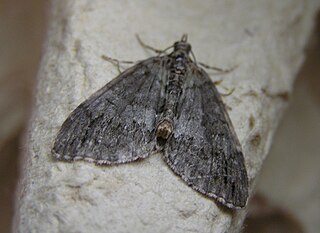
Euphilotes is a genus of butterflies in the family Lycaenidae, which consists of a number of species found in western North America. Some of the species are endangered, such as the Smith's blue, Euphilotes enoptes smithi.

Crambidia is a genus of moths in the family Erebidae. The genus was described by Packard in 1864.
Choristostigma is a genus of moths of the family Crambidae.

Frechinia is a genus of moths of the family Crambidae.
Leptosteges is a genus of moths of the family Crambidae.

Xubida is a genus of moths of the family Crambidae.
Loxostegopsis is a genus of moths of the family Crambidae.

Euxoa is a genus of moths of the family Noctuidae raised to Genus by the German entomologist, Jacob Hübner. The Genus is mostly confined to dry and semi dry areas in the Northern Hemisphere. There 130 species in Eurasia, a few in Africa, and 175 in North America. There are no species in the Genus in South-East Asia or in Australia. In North America, most species are found in Western regions. Of the North American species, 4 are endemic to Mexico. There is one species recorded from Chile, but this may be a mislabeled specimen. In real terms, species numbers do not equal species abundance. Some areas with few species have large numbers of the ones that do live there.

Anavitrinella is a genus of moths in the family Geometridae erected by James Halliday McDunnough in 1922.

Digrammia was a genus of moths in the family Geometridae erected by Carl Freiherr von Gumppenberg in 1887. It is now often considered a synonym of Semiothisa.

Hydriomena is a genus of moths in the family Geometridae described by Jacob Hübner in 1825.

Nemoria is a genus of emerald moths in the family Geometridae. It was named by Jacob Hübner in 1818.

Sicya is a genus of moths in the family Geometridae erected by Achille Guenée in 1857.

Stenoporpia is a genus of moths in the family Geometridae erected by James Halliday McDunnough in 1920.
Acroncosa is a genus of snout moths in the subfamily Phycitinae. It was described by William Barnes and James Halliday McDunnough in 1917. The type species is Acroncosa albiflavella.

Euphilotes battoides, the square-spotted blue or buckwheat blue, is a species of butterfly of the family Lycaenidae. It is found in western North America from Washington south to Baja California Norte and then west to southern Colorado and New Mexico.
Cacotherapia is a genus of snout moths. It was described by Harrison Gray Dyar Jr. in 1904 and is known from the United States, Guatemala, Mexico, and Panama.
Chararica is a genus of snout moths. It was described by Carl Heinrich in 1956.
Acroncosa similella is a species of snout moth in the genus Acroncosa. It was described by William Barnes and James Halliday McDunnough in 1917. It is found in the US state of California.
Givira is a genus of moths in the family Cossidae.











